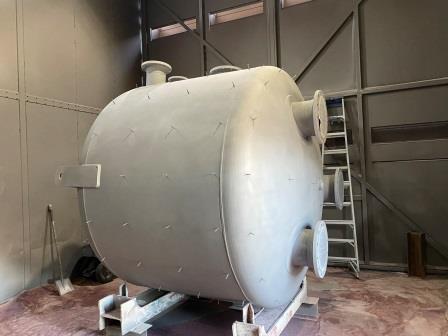Watch our Most Recent Videos | Visit us on LinkedIn | Visit us on YouTube
SSPC-SP 7 Brush-off Blast Cleaning (NACE No. 4)
SSPC-SP 7 Brush-off Blast Cleaning (NACE No. 4) is a standard used for brush-off blast cleaning put forth by the Society for Protective Coatings (SSPC) and NACE International Standard. Brush-off blast cleaning is to be used for a defined degree of cleaning unpainted and painted steel surfaces prior to protective coating or lining systems.
SSPC-SP 7 Brush-off Blast Cleaning is addressed in I4I Academy Source Inspector training course. External corrsion caused by coating faluire is covered in our API 570 piping inspector, API 510 pressure vessel inspector and API 653 storage tank inspector course.
SSPC-SP 7/NACE No. 4 brush-off blast cleaning allows for a great amount of the original coating to remain on the surface and to roughen the surface prior to applying the new coating system. SSPC-SP 7/NACE No. 4 removes all visible oil, grease, dust, dirt, as well as loose mill scale but tightly adherent mill scale, rust, and the coating may remain.

Why SSPC-SP 7 Brush-Off Blast Cleaning (NACE No. 4)?
In reference to the degree of cleanliness for SSPC-SP 7/NACE No. 4 brush-off blast cleaning has a lower degree of cleaning surfaces than does SSPC-SP 14/NACE No. 8 industrial blast cleaning. SSPC-SP 7/NACE No. 4 allows for tightly adherent contaminants to remain on the surface. The low cost of this blast cleaning provides for an economical protection in mild environments when blast cleaning is required.
What Should You Consider?
For SSPC-SP 7/NACE No. 4 brush-off blast, the entire surface is subject to brush-off blast cleaning. Adherent contaminants are not required to be removed if a dull putty knife cannot remove it off the surface after brush-blast cleaning. Flecks of the steal do not need to be considered under the original coating.
Special note should be taken on the coating specified with the degree of surface roughness that is suitable for the coating system of interest.
What is needed to be done before SSPC-SP 7 Brush-off Blast Cleaning Process?
There are prerequisites that need to be in place prior to applying SSPC-SP 7/NACE No. 4. In order to be able to apply brush-off blast cleaning be sure that all visible oil, grease, and other contaminant residues are removed.
This can be achieved by using standard SSPC-SP 1 Solvent cleaning or other possible methods. Some specification might require a chloride test to determine amount of deposited soluble salt.
Environmental Conditions needed for SSPC-SP 7 Brush-off Blast Cleaning
Substrate temperature should not be colder surrounding air temperature; otherwise, the moisture can condensate on the cleaned-blast surface and cause flash rust. Relative humidity should be less than 85% since the higher value can cause moisture condensation on the surface.
The sandblasting process should not be done if the surface temperature is less than 5-degree Fahrenheit(or 3-degree Celsius) above the dew point. The dew point is the temperature that condensation starts.
In addition, all conditions mentioned in the coating specification must be met. The specification is part of the contract and have established requirements that must be met per project.
Therefore, the surface must be free of sharp fins, edges, welt spatter, or burning slag as indicated by the coating specification prior to performing brush-off blast cleaning, SSPC-SP 7/NACE No. 4. Please note brush-off cleaning is two level lower than SSPC-SP 10 (Near-White Metal Cleaning) and 3 level lower than SSPC-SP 5 (White Metal Cleaning).
What Methods can be used for SSPC-SP7/NACE No.4?
SSPC-SP 7 Brush-off blast cleaning can be done by dry abrasive blasting in the following ways:
- Using compressed air, blast nozzles, or an abrasive
- Using a closed-cycle, recirculating system with compressed air, blast nozzle, and an abrasive, with or without vacuum for recovery of abrasives and dust.
- Using a closed-cycle, recirculating system with centrifugal wheels and an abrasive.
- Additional methods can be discussed between the contractor and those who established the requirements.
What Abrasives can be used for Brush-off Blast Cleaning?
For SSPC-SP 7 brush-off blast cleaning, the coating specification indicates the limitations and specifications on all abrasives and their conditions per project and therefore, should be followed to meet the service requirements.
Abrasives are used for grinding, polishing, or cleaning hard surfaces. SSPC-SP 7 brush-off blast cleaning calls for the use of abrasives in the methods listed. The abrasives selected for this method depend on a variety of factors.
In order to select an appropriate abrasive, the type, grade, and surface condition of the steel need to be considered. The size and type of abrasive should be selected based off the blast cleaning system to be used, the surface that requires SSPC-SP 7/NACE No. 4, the finished requirements of the surface, and if recycling of the abrasive is necessary.
The abrasive used for brush-off blast cleaning should be dry and free of any contaminants, such as oil, grease, etc. The air compressor should be checked for oil and water contamination by blotter test.
The coating specification might call for surface profile measurement.
Post SSPC-SP 7/NACE No. 4 Brush-off blast Cleaning?
Once the methods above have been applied, be sure to remove all visible residues off the surface. This can be achieved with the use of brushing, blowing off residue with clean, dry air, and vacuum cleaning. A surface dust test might be necessary.
As mentioned prior, after brush-off blast cleaning, be sure to meet all surface standards as presented in the procurement documents. Unperfected surfaces may lead to premature paint failure.
As with all standards, it is very important to take the necessary precautions when working with blast cleaning.
Free newsletter!
Sign up to receive my monthly newsletter covering all the latest courses and updates.




New! Comments
Have your say about what you just read! Leave me a comment in the box below.